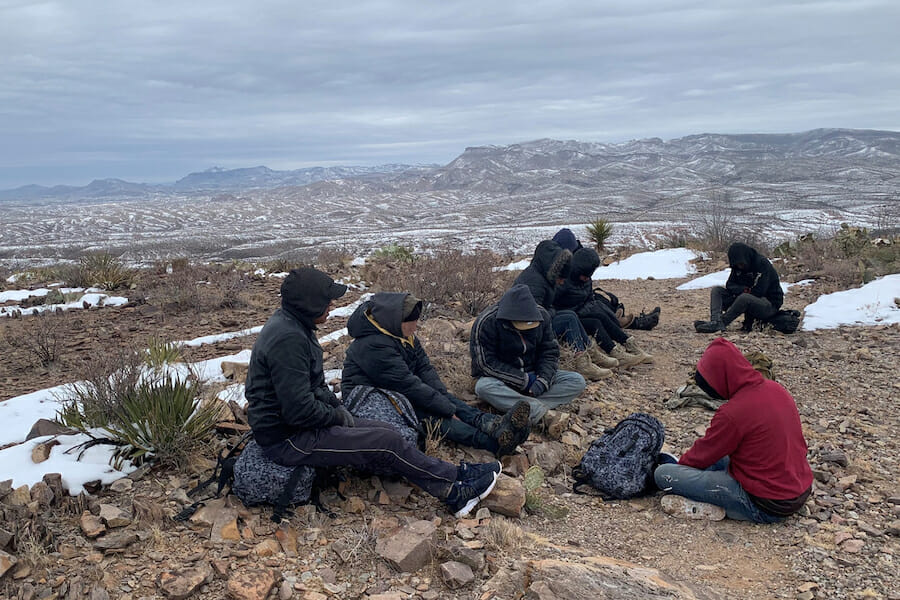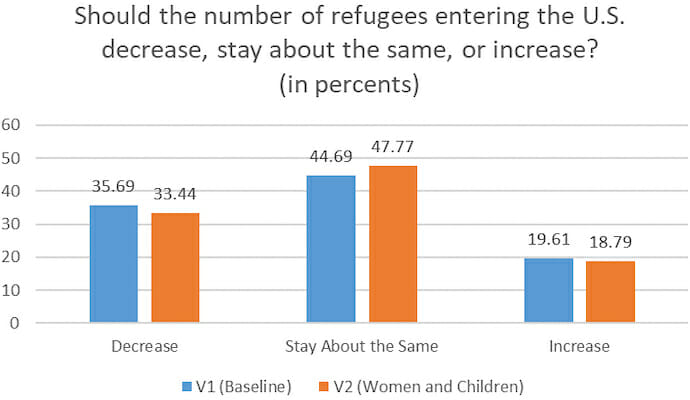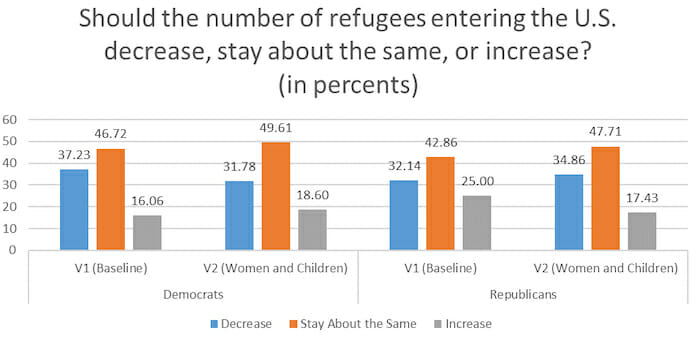
Politics
Does the Framing of a Refugee Question Change Public Opinion?
The Trump administration was heavily criticized for implementing numerous barriers to refugee entry, including reducing caps on the number of refugees that would be accepted each year. However, in the eyes of refugee advocates, the Biden administration has not fared much better, with Vice President Kamala Harris stating “Do not come. Do not come…If you come to our border, you will be turned back.” While the Biden administration has announced incremental reforms to ensure refugee safety, refugee experts argue that Biden needs to remove language in Title 42 of the United States Code, used to justify expelling thousands of refugees under the purview of public health.
According to research by Mariano Sana covering public opinion on refugees from 1938-2019, Americans tend to view the number of refugees in the U.S. as “about right.” Yet, despite the growing global refugee crisis, the annual refugee ceilings under the Trump administration were the lowest in 40 years and have not returned to pre-Trump levels under the Biden administration.
Presidential administrations have chosen to keep relatively low refugee ceilings partly because of the public backlash. When examining the Syrian refugee crisis, it is easy to see a clear change in U.S. public opinion of refugees. Before the San Bernardino and Paris terrorist attacks, only 19% of U.S. survey respondents believed that the U.S. should stop admitting refugees and 44% of respondents felt like the U.S. should be doing more to aid refugees. However, after the terrorist attacks, there was a shift in the perception of Syrian refugees as threats. Another survey showed that after the San Bernardino and Paris attacks, 53% of Americans said that the U.S. should stop receiving refugees altogether. While these events occurred during the Obama years, this anti-immigrant sentiment carried through the 2016 election and allowed the Trump administration to easily lower the refugee ceiling with little public backlash.
Not all refugees have been perceived in the same light, with perceptions of refugees differing based on who they are and where they come from. Critiques focus on the reasons for fleeing one’s home country, the economic and security costs for hosting refugees, and the ability to integrate into American society. Past research has found that Americans tend to prefer non-Muslim refugees and women and children. If women and children are seen by the public as more sympathetic and deserving of refugee status, this should increase support for refugee policies overall. However, considering the increase of unaccompanied minors arriving at the U.S.-Mexico border and broader anti-immigration sentiment, such support for women and children has declined.
To assess public opinion of refugees, we recruited 625 Americans, using quota sampling, to respond to an online survey through Qualtrics on June 22-24. Through random selection, the respondents received one of the following two questions about refugees.
V1: In fiscal years 2018, 2019, and 2020, the U.S. admitted approximately 23,000, 30,000, and 12,000 refugees respectively. Should the number of refugees entering the U.S. decrease, stay about the same, or increase?
V2: In fiscal years 2018, 2019, and 2020, the U.S. admitted approximately 23,000, 30,000, and 12,000 refugees respectively, including many women and children. Should the number of refugees entering the U.S. decrease, stay about the same, or increase?
 Among respondents that received version 1, approximately 36% answered that they wanted the number of refugees to decrease, 20% wanted an increase, and 45% wanted the number of refugees to stay the same. However, those that received version 2, which specifically mentioned refugees as women and children, respondents viewed refugees slightly more favorably, with 2% fewer advocating for a decrease and 3% more stating it should stay about the same. The lack of support for an increase when focusing attention on women and children suggests that simple framing may no longer elicit the same sympathy due to host fatigue.
Among respondents that received version 1, approximately 36% answered that they wanted the number of refugees to decrease, 20% wanted an increase, and 45% wanted the number of refugees to stay the same. However, those that received version 2, which specifically mentioned refugees as women and children, respondents viewed refugees slightly more favorably, with 2% fewer advocating for a decrease and 3% more stating it should stay about the same. The lack of support for an increase when focusing attention on women and children suggests that simple framing may no longer elicit the same sympathy due to host fatigue.
Divided by party identification, Democrats were marginally more likely to support additional refugees under version 2, while those supportive of reducing refugee numbers declined by over 5%. Among Republicans, we see marginal change in reducing refugee numbers, but a 7% decline in increasing. However, across both groups, respondents were slightly more likely to support maintaining the same levels if women and children were mentioned, suggesting that division is less partisan than one might expect.
 Based on the data, it appears that how the refugee issue is framed can invoke a sympathy effect, where survey respondents are more supportive when answering contextualized questions versus abstract ones. However, the women and children framing in our survey on its own does not seem to have a substantially large effect that would motivate more effective policies for refugee resettlement. We assume that if the public was more knowledgeable of the circumstances in which refugees are seeking asylum they would be more supportive of a higher refugee ceiling. If so, pairing the women and children framing of our survey with more explicit references to the unique challenges these refugees face may be more persuasive.
Based on the data, it appears that how the refugee issue is framed can invoke a sympathy effect, where survey respondents are more supportive when answering contextualized questions versus abstract ones. However, the women and children framing in our survey on its own does not seem to have a substantially large effect that would motivate more effective policies for refugee resettlement. We assume that if the public was more knowledgeable of the circumstances in which refugees are seeking asylum they would be more supportive of a higher refugee ceiling. If so, pairing the women and children framing of our survey with more explicit references to the unique challenges these refugees face may be more persuasive.
The results suggest difficulties in gaining broader sympathy for refugees, which will likely complicate efforts at raising the ceilings on refugees accepted each year. It also does little to address the underlying demand for relocation and may leave the U.S. ill-prepared for future refugee crises, as demand shifts from political crises to displacement from natural disasters exacerbated by climate change. According to data from IEP, an Australian think tank, at least 1.2 billion people can be expected to be displaced by 2050. Without an effective strategy for today’s refugee crises, the U.S. will be unprepared to deal with tomorrow’s “climate refugees.” Thus, it is crucial to analyze not only the effective means to process and integrate refugees but to understand what influences public perceptions of refugees.
Funding for this survey was provided by the Mahurin Honors College at Western Kentucky University.


